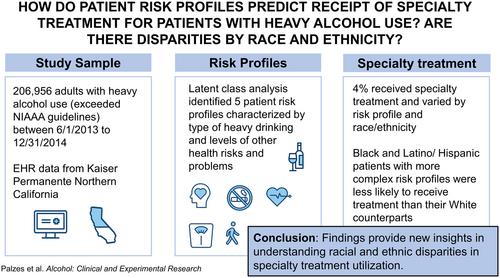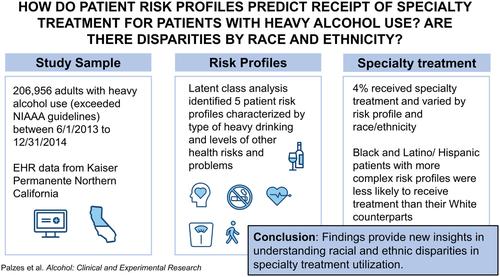Racial and ethnic disparities in receipt of specialty treatment across risk profiles of adults with heavy alcohol use
Abstract
Background
Variation in specialty treatment utilization for alcohol use disorder (AUD) by patient subgroups is poorly understood. This study examined whether and how patient risk profiles predict receipt of specialty treatment and whether there are disparities by race and ethnicity.
Methods
This cohort study included 206,956 adults with heavy alcohol use (that which exceeded National Institute on Alcohol Abuse and Alcoholism guidelines) between June 1, 2013 and December 31, 2014, using electronic health record data from Kaiser Permanente Northern California. Five risk profiles (characterized by daily or weekly heavy drinking and level of health risks) were identified in latent class analysis. Logistic regression models were fit to examine associations between risk profiles, race, ethnicity, and receipt of specialty treatment (including addiction medicine, psychiatry, or integrated behavioral health visits, and AUD pharmacotherapy), adjusting for other patient characteristics. Variation in the association between risk profiles and receipt of specialty treatment by race/ethnicity was also examined.
Results
Overall, 4.0% of patients received specialty treatment. Latino/Hispanic and Asian/Pacific Islander patients had lower odds of receiving specialty treatment than White patients (adjusted odds ratio [aOR] [95% CI] = 0.80 [0.75, 0.85], and 0.64 [0.59, 0.70], respectively). The substance use disorder and mental health disorder (SUD/MH) risk profile had the highest odds of receiving specialty treatment (10.46 [9.65, 11.34]). Associations between risk profiles and receipt of specialty treatment significantly differed by race/ethnicity. Black patients in the SUD/MH risk profile, and Hispanic/Latino patients in the risk profile with heavy daily drinking and more health risks, had lower odds of receiving specialty treatment than their White counterparts (adjusted ratio of odds ratios [aROR] [95% CI] = 0.69 [0.50, 0.94], and 0.79 [0.67, 0.92], respectively).
Conclusions
This study provides new insights into racial/ethnic disparities in specialty treatment utilization for alcohol problems. Findings may help inform strategies for tailoring interventions to address heavy alcohol use.



 求助内容:
求助内容: 应助结果提醒方式:
应助结果提醒方式:


